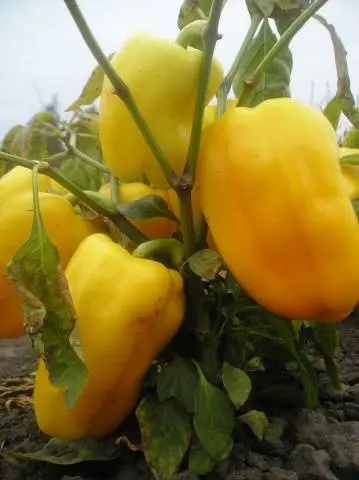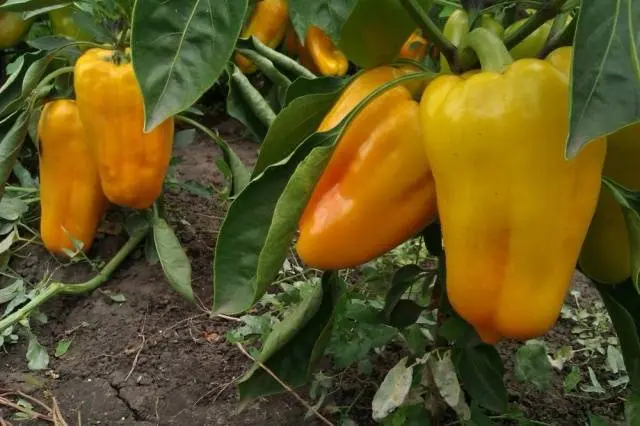Yellow varieties of sweet bell pepper differ from red varieties not only in their color. The main difference between them is the concentration of nutrients. Yellow peppers have more vitamin C and pectin, while red peppers have more beta-carotene. That is why yellow varieties of sweet peppers are a godsend for people who adhere to a healthy diet, as well as for people who are allergic to red vegetables. One of the most popular varieties of yellow pepper is the Gladiator variety.

Characteristic of the variety
Pepper Gladiator is the result of the work of Dutch breeders. In terms of maturation, it belongs to mid-season varieties. Gladiator peppers reach their technical maturity between 110 and 120 days after germination. Its plants are vigorous and spreading. Their average height will not exceed 55 cm. The gladiator is perfect for both greenhouses and open beds and film shelters.
Gladiator peppers have a truncated pyramidal shape. On its surface, in addition to a slight glossy sheen, you can see a slight ribbing. The color of the fruit changes depending on the degree of their maturity. Light green unripe peppers gradually turn yellow, acquiring a bright yellow color. Large fruits of the Gladiator can have a weight of up to 350 grams and a wall thickness of up to 13 mm. Their thick, firm flesh is incredibly tender and sweet with a slight peppery flavor. Its use is universal: from fresh consumption to conservation.

This variety of sweet pepper has not only excellent taste characteristics, but also marketable. Its plants and fruits have good resistance to many diseases of this culture, especially to verticellosis. Among other things, Gladiator is a very productive variety, allowing you to collect from 9 to 12 kg per square meter.
Recommendations for growing
Seeds can simply be planted in prepared containers, but such a planting will not be able to provide high germination. Experienced gardeners recommend preparing seeds in advance:
- All seeds are immersed in a container of water. Seeds that float to the surface are empty and unsuitable for planting.
- Soaking seeds in water for a period of not more than 2 days. To increase the rate of their germination, any growth stimulator can be added to the water.
- Seed treatment with a weak solution of potassium permanganate. After that, they should be washed with warm water.
Such seed preparation will not only accelerate the appearance of the first shoots, but also strengthen their immunity.
When planting, the seeds of the Gladiator variety are buried no more than 1,5 cm. Before the first shoots appear, they are covered with polyethylene or glass. For successful germination, they should provide a temperature of 23 to 28 degrees.
Young seedlings are planted in a permanent place at the age of 60 days. Gladiator is a fairly thermophilic variety, so the place for its landing should be sunny and protected from the wind. In the ground before planting this variety, it is recommended to apply any organic fertilizer in the fall. If a crop rotation is organized on the site, then it is better to plant pepper after the following crops:
- beans;
- cucumbers;
- root crops and others.
Good results are shown by planting sweet peppers after green manure. In addition, they can be used for soil mulching.
Regardless of whether the Gladiator is planted in open or closed ground, there should be 35–40 cm of free space between adjacent plants.
The sweet pepper variety Gladiator is undemanding to care, but for abundant fruiting it needs to be provided:
- Lots of light and heat. If peppers are planted in open ground, then at first they can be covered with a film at night. When landing in a greenhouse, you need to remember about regular ventilation. This is especially important during the formation of buds and fruits.
- Regular watering. As a rule, in our climate, the frequency of watering this crop will be at least 2 times a week. In this case, the top watering can be done only until the moment of flowering. After the formation of buds, watering is carried out only under the root. For each Gladiator plant, the water rate is from 1 to 3 liters. It should only be warm. Watering with cold water will have a negative effect on the root system of plants.
- Regular loosening and weeding. Soil mulching can replace these procedures. Straw or green manure is perfect for sweet pepper Gladiator in the form of mulch.
- Top dressing with mineral and organic fertilizers. They should be carried out 2 weeks after planting, during the period when buds begin to form, and then during the period of active fruit growth. Excellent results are obtained by the use of bird droppings, slurry, as well as superphosphate.
With proper care, the sweet pepper variety Gladiator can bear fruit profusely from mid-July to October.
We recommend that you familiarize yourself with the ten most common mistakes when growing sweet peppers:









